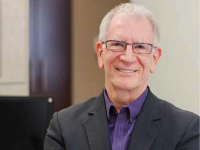Mark Sisson's Blog, page 277
December 20, 2014
Oven Baked Chowder
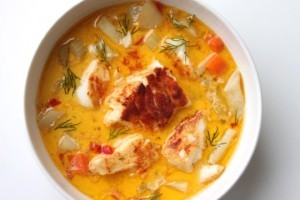 Meals like this oven-baked chowder are exactly the type of recipes that instantly become keepers. Why? The chowder is deeply flavorful and the fish and veggies cook perfectly every time, with little assistance from you. Plus, it’s a one-pot meal that serves up both protein and veggies and leaves behind only a few dirty dishes.
Meals like this oven-baked chowder are exactly the type of recipes that instantly become keepers. Why? The chowder is deeply flavorful and the fish and veggies cook perfectly every time, with little assistance from you. Plus, it’s a one-pot meal that serves up both protein and veggies and leaves behind only a few dirty dishes.
Change the recipe up seasonally with different vegetables, or stick with this tried and true combination of parsnips, carrots and bell pepper. Using different types of fish is an option, too; sea bass and halibut are always delicious, and wild salmon, of course, is never a bad choice for its abundant omega-3s.
Is this traditional chowder? No, but it’s just as good (or maybe even better).
Servings: 4
Time in the Kitchen: 1 ½ hours
Ingredients:
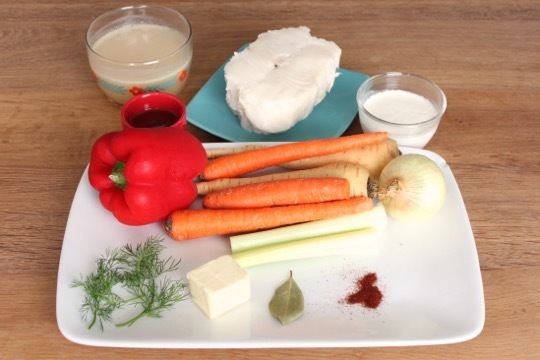
1 ½ pounds fish, each fillet about 1 inch thick, skin removed (680 g)
½ teaspoon kosher salt (2.5 ml)
½ teaspoon paprika (2.5 ml)
2 parsnips (or other root vegetable), thinly sliced or cut into 1-inch cubes
3 carrots, thinly sliced
2 celery stalks, thinly sliced
1 small onion, finely chopped
2 tablespoons olive oil (30 ml)
2 ½ cups chicken stock (600 ml)
1 tablespoon unsalted butter, cut in small chunks (15 g)
1 bay leaf
1 red pepper, thinly sliced or finely chopped
½ cup whole cream or coconut milk (120 ml)
4 sprigs of fresh dill, finely chopped
Instructions:
Preheat oven to 375 ºF/190 ºC.
Season fish with kosher salt and paprika. Set aside.
In an 8×11 or similar sized baking dish, toss parsnips, carrots, celery and onion with olive oil. Spread out evenly in the baking dish.
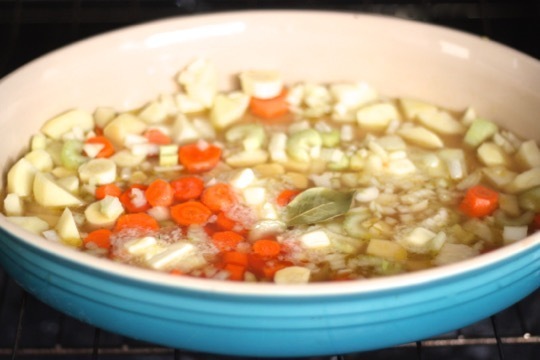
Bring the chicken stock to a boil in a saucepan on the stove. Pour over the vegetables.
Evenly sprinkle the butter on top. Add the bay leaf.
Cover the baking dish tightly with a lid or aluminum foil. Bake 30 minutes.
Add the fish and the red pepper and bake again, covered, for another 30 minutes until the fish is just cooked through and easily flakes apart with a fork.
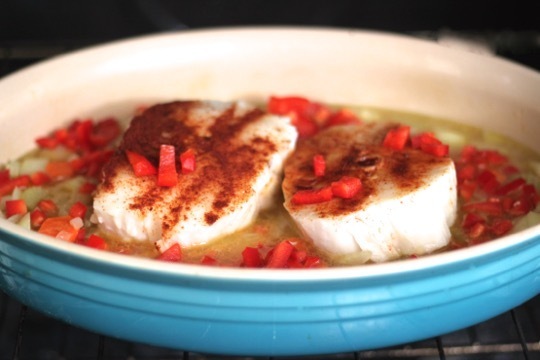
Gently heat the whole cream or coconut milk and stir into the chowder. Sprinkle the fresh dill on top.
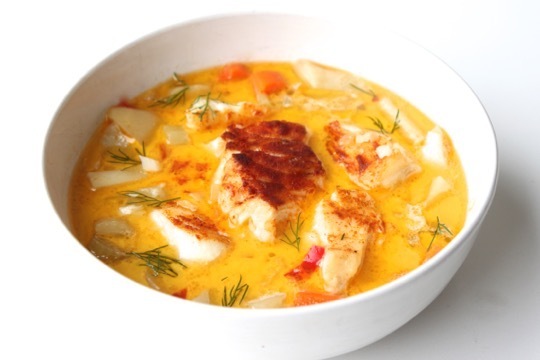
Not Sure What to Eat? Get the Primal Blueprint Meal Plan for Shopping Lists and Recipes Delivered Directly to Your Inbox Each Week


December 19, 2014
The Way I Used to Live Life Was Slowly Destroying Me
The Way I Used to Live Life Was Slowly Destroying Me
It’s Friday, everyone! And that means another Primal Blueprint Real Life Story from a Mark’s Daily Apple reader. If you have your own success story and would like to share it with me and the Mark’s Daily Apple community please contact me here. I’ll continue to publish these each Friday as long as they keep coming in. Thank you for reading!
 My story is interesting because I could have died.
My story is interesting because I could have died.
You would think that a healthcare professional like myself would have learned everything that was necessary to be personally healthy. At least two years ago I would have thought that—but, not true. Medical and dental professionals have a paltry amount of nutritional training—and no training in the importance of primal nutrition and lifestyle.
I am a periodontist: a dentist who has specialized in the treatment of gum disease. Today, I have been in practice in South Carolina for 40 years. That is a long time. When my story began, I was in practice for 32 years.
Here is my story:
Up until December 2006, I was treating my body as well as I thought was appropriate. I ate low fat, high fiber foods including grains, skim milk, fish, and meat. I didn’t like non-starchy veggies, but I thought I was doing just fine. I exercised aerobically 4-5 days a week for about 40 minutes a day. One of my loves was to snack on popcorn, which I believed supplied me with healthy fiber.
Then, in December 2006 I had a life-changing event. My daughter (who was staying with me and my wife while her family was transitioning to Portland, Oregon from Charleston, South Carolina) was sitting on our living room floor while I was standing with my laptop in my hands. All of a sudden I felt a shock traveling from the computer up my arm. I dropped the computer on my sofa, and my daughter exclaimed, “What’s wrong?” I said that I just got a shock from my computer. Her response was, “Dad, don’t be so melodramatic.” A week later, I had a stroke.
The stroke must have occurred while I was sleeping. When I woke up, my grandson was at our house, and I attempted to ask him if he wanted to go out for breakfast. But the words could not come out. I was unable to speak. I felt fine, but I couldn’t speak. My wife, who is a nurse, realized what was happening, and drove me to the hospital. I was lucky.
My doctors explained that the “shock” that I thought was from my computer was actually a TIA (Transient Ischemic Attack). Many people who have a stroke will experience a TIA days or weeks before the stroke as a warning sign of an impending crisis. I was not aware of such a warning sign, so I paid no attention to it.
While in the hospital for a week, my cardiologist and internist put me on three types of blood pressure meds, a cholesterol med, and an acid reflux med. My vascular surgeon put me on 81mg aspirin and Plavix. Their medical advice was for me to take these meds for the rest of my life. Within three weeks, I was able to speak normally. I returned to work after six weeks.
After my stroke, I knew that I needed to get educated about good nutrition. So, I began my reeducation. In April 2013, I enrolled in a 5-day nutrition course that changed my life. I was excited because I believed that this was going to be the program I had searched for to confirm that what I was doing currently was correct. I hoped to learn a few new things to hone my skills and update the knowledge that I already acquired. This program wasn’t about basic nutrition; it was about primal nutrition—the foods and lifestyles that allowed our species to thrive for 2.5 million years. What I learned in those informative and enlightening five days did change my life. I learned that almost everything I was doing was wrong. That blew me away!
Among other things, I learned that most processed foods were making us sick. I learned that modern grains of any type were one of the worst things I could put in my body. I learned that healthy fats were essential, and anything that had low fat or no fat was unhealthy. I learned that all the fruit I was eating contributed way too much sugar to my body, and leafy greens and other multicolored veggies were required at every meal. I also learned that exercise needed to be efficient, sleep needed to be restorative, and that sitting most of the day was almost as bad as smoking. Wow!
So, I traveled back to my home in Charleston, SC and informed my wife of what I learned. She was not happy. But, she allowed me to make a 30 day test of my new fangled ideas. We removed all the processed foods, grain products, and sugar aliases from our pantry and fridge, which added up to seven grocery bags that I took to my local food bank. We joined our local CSA (Community Supported Agriculture) program to obtain locally grown, organic veggies weekly. The foods we started eating consisted of grass fed beef and wild caught fish; all kinds of shellfish; free range chicken, liver, and eggs; all kinds of vegetables raw and cooked; some deeply colored fruits and occasionally nuts and seeds that we soaked overnight.
At that time, my meds were still the same. My HDL was 48, my triglycerides were 120, and my resting blood pressure was 137/87 even with three blood pressure meds. I weighed 184 pounds. My physicians’ advice was, “Continue to take your meds.” Unfortunately, my physicians were ignorant of the science of primal nutrition and lifestyle, as I believe most physicians are.
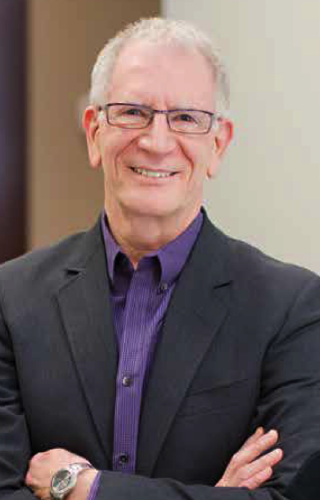 Today is 20 months since beginning an active primal lifestyle. I am still practicing periodontics, and I plan to continue treating my patients for the foreseeable future. As I am writing this, my resting blood pressure is 119/72, and my pulse rate is 54. My HDL is 76, and my triglycerides are 112. I weigh 154 pounds.
Today is 20 months since beginning an active primal lifestyle. I am still practicing periodontics, and I plan to continue treating my patients for the foreseeable future. As I am writing this, my resting blood pressure is 119/72, and my pulse rate is 54. My HDL is 76, and my triglycerides are 112. I weigh 154 pounds.
It has been stated that it takes one month of repairing a nutritionally damaged body for every year of the manifestation of a disease. I am still a work in progress; I have much farther to go to regain optimal health. I am patient, but I am diligent and motivated. I can’t believe the way I used to live was slowly destroying me. I can never return to the way it used to be. I am a changed person, and I want to spread the word.
The doctors who I depended on in 2006 while I was having a stroke were exceptional. They saved my life, but I had to learn how to get healthy on my own. I only learned what was going on in my body after I learned about evolution and how our ancestors thrived.
Why didn’t my physicians help me understand why I had a stroke, and how I should improve my lifestyle to get healthy? Why didn’t my physicians explain how I should wean off my meds over time? The science is there, but most of the medical profession hasn’t gotten the message.
While making a change in my life, I also am making a change in my patients’ lives. I teach all my periodontal patients primal nutrition and lifestyle. When you enable each cell in the body to function properly by giving it what it needs—which is nutrient-dense real foods and exercise and sleep and reduction in all types of stresses—each cell will help all other cells to thrive. Your gut will become healthier; your overall body will become healthier; and your mouth will become healthier.
In June of this year, I received the designation of Certified Functional Medicine Practitioner, and in September I received the Primal Blueprint Certified Expert designation. I’ve reenergized my life and reengineered my professional career. I offer the knowledge that I have learned to all my patients and to all who want to listen.
Alvin Danenberg
You CAN Lose Weight and Get Healthy. Find Out How>>


December 18, 2014
The Pros and Cons of Comparing Yourself to Others
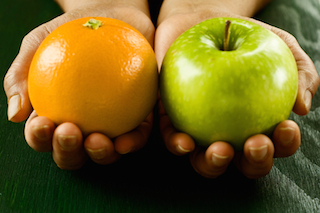 After all these years, I still find it interesting how lessons from my athlete days can pop up in other areas of life. In my competition era, for example, one of the things that helped me continually better my performance was a well-honed, disciplined inner focus. In the deep reaches of a marathon, I better be focused on myself. That doesn’t mean I never had awareness of where other people were in relation to me – although those moments happened, too. It means I couldn’t afford to spend my energy outside of myself in those grueling hours. In a game of mind over matter, you learn not to waste critical mental resources.
After all these years, I still find it interesting how lessons from my athlete days can pop up in other areas of life. In my competition era, for example, one of the things that helped me continually better my performance was a well-honed, disciplined inner focus. In the deep reaches of a marathon, I better be focused on myself. That doesn’t mean I never had awareness of where other people were in relation to me – although those moments happened, too. It means I couldn’t afford to spend my energy outside of myself in those grueling hours. In a game of mind over matter, you learn not to waste critical mental resources.
Focusing on others and getting diverted by comparison would’ve been one of those perilous mistakes. Your race isn’t about other people and where they are. It’s about your training, your focus, your pacing, your state of mind. Some folks can come with a plan that they’ve developed over months but get thrown off course by paying too much attention to other people’s approach. Suddenly, they’ve expended more energy than they’re used to in the beginning sections of a race, and now they’ve lost touch with their rhythm. They struggle to recalibrate their pacing. It’s disorienting and you can guess how unsuccessful. Funny how the same principle can hold in many regards when it comes to success in life – and health. Undoubtedly, there’s a time (and a place) for comparison. I’ve used it to my advantage – in many endeavors. The key, I find, is to be mindful of when you turn to comparison and what you’re looking to get from it.
There’s an important distinction to be made here, first off. Exercising or training (insert any health/life endeavor) with other people, offering mutual encouragement – that’s community. There’s legitimately something to the group dynamic in exercise. The presence and energy of other people can be a welcome distraction. They can help make light of arduous fitness tasks. They can offer support. They can share the physical and emotional journey, so to speak. Having a witness to our struggles and accomplishments is powerful.
Setting their performance or ability against your own, on the other hand – that’s comparison. The first doesn’t beget the second, but it can sometimes accompany it. The same holds for many situations, whether it’s losing weight, getting in shape, rebuilding your health, cultivating your career, growing your financial situation, pursuing creative projects, or simply designing a life trajectory. How we handle our inclinations toward community and comparison is up to us.
The Upside of Comparison
According to social comparison theory (in a nutshell), we compare ourselves to others for information gathering – as a means of expanding and/or honing our frame of reference for self-assessment. It presumably gives a reality check when objective measures aren’t present or aren’t deemed as relevant. In some cases, we also compare ourselves because we want to boost our motivation to achieve more by finding motivation in the examples “upward” comparison (e.g. someone fitter, more successful, etc.) provides. In other circumstances, we choose to indulge in so called “downward” comparison to presumably boost our self-esteem by focusing on people in worse situations than those in which we perceive ourselves to be (e.g. more overweight, less fit, less successful, etc.).
On the positive end of things, comparison can offer an “information gathering” framework. We may not realize what’s even possible without the model of other people. The example of other people can expand our sense of what we can imagine for ourselves. Maybe we never before understood the variety of approaches to getting fit or preparing all of our own meals. Maybe we never believed it was possible to work from home or balance the need for personal time with family commitment. Likewise, seeing their struggles and success can help us anticipate the stumbling blocks and appropriate solutions for our own endeavors.
Nonetheless, I’d say these examples are the more innocuous forms that fall more under the “observation” umbrella than the true comparison.
In terms of true “assessment”-focused comparison as we often think of it, the impact on our behavior can be varied but clear. As I’ve noted before, studies support the notion that we tend to use the people in our inner circles as “norms” against which we gauge our eating and even weight. Within that premise, we can feel genuinely motivated to perform better (or to be lulled into acquiescence). Research suggests, for example, that people will up their game solely based on their perception of the person exercising next to or with them. (PDF) One of our inclinations is to push ourselves – or in other cases, slouch – to match those around us. Experts believe comparing some element of ourselves can actually support self-esteem as well as encourage self-enhancement.
The Downside of Comparison
Yet, not every act of comparison emboldens us. Although research in the area of social comparison shows that we tend to compare ourselves to others who are somewhat similar rather than vastly different in ability/characteristics/other aspect up for evaluation. (PDF) Nonetheless, I believe we often look for the comparison we’re primed to seek out – whether by our own emotional insecurities or the novelty of modern media. How many of us have at some point watched the fittest people in the gym and wanted to slink away to the other side of the room? How many of us seen media photos of the super-lean and felt like giving up?
On the other hand, maybe we’ve taken a few steps to clean up our diet and not felt motivated to go much further because our choices seem so much better than the people in our families and workplaces. It’s all too easy to feel good about a few steps when almost everyone we know is still back at the starting line.
I think we need to be entirely honest – which also means mindful – about the motivation behind our comparisons. What are really looking at when we’re glancing around the gym during our rest periods? What’s really going through our heads when we head for the back row (or the front row) at a fitness class? What are we looking to see in other people? Are we information gathering – on techniques or ideas? Or are we looking for ammunition to use against ourselves to affirm rooted thinking – or for justifications to boost our egos?
There’s nothing wrong with asking legitimate questions that lead us toward productive self-assessment. How is that person pacing his/her workout? How does he/she enjoy training? How does that person exude self-confidence? The inevitable next question to these ponderings is, “Why not me?”
Healthy comparison should bring us back to empowerment. Marcus Aurelius presumably said, “How much time he gains who does not look to see what his neighbor says or does or thinks, but only at what he does himself….” I’d add how much additional peace and energy to that proposal.
For every five minutes we spend comparing our abilities to another person’s, we’d do well to make sure we’re devoting an hour to assessing our own progress and doing something (anything healthy) to celebrate it.
You are your ultimate frame of reference – your own evolution. Track whatever you need to be able to measure your self-comparison. Keep you mind on your own race. Hone your own performance by understanding and following what shows you your progress.
Be honest with yourself about what offers you positive inputs for consideration (e.g. ideas) and what pushes you too far for the time being. It’s my experience that people’s confidence grows as their fitness grows and their self-investment increases. You don’t have to have it all down right out of the starting gate. Stay away from media that sends you down a negative comparison spiral. Be careful with settings that trigger the insecurity, but don’t use that as an excuse to avoid resources that would be legitimately helpful.
In the context of this honesty, you must commit to seeing yourself in a more generous light. If you’re your own worst critic, if you indulge in self-bashing, excuses or victimhood, then it’s time you owned that. Trust me, no matter what other people around you are doing, it won’t matter more than your attitude does.
Finally, lean on like-minded community, and make sure you aren’t going it alone. Again, community supports rather than compares. Isolation breeds comparison. When you feel yourself integrated with others, you feel more secure. When you’re known and supported, it’s not about comparing aspects with envy or arrogance. It’s about knowing and being known as a full, aspiring, fallible human being – the way we all endeavor our journeys, for whatever health, fitness or personal aspiration. Ground yourself in that commonality, and look to better yourself – on your own terms.
Thanks for reading today, everyone. How has comparison served or sabotaged you in the past? I’m curious to hear your feedback. Have a great end to your week.



December 17, 2014
Happy Holidays from Lil’ Grok and the Korgs!
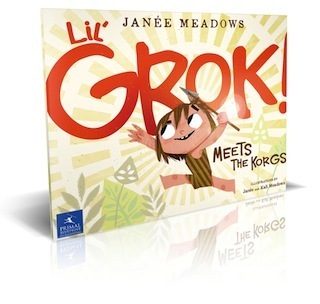 It’s that time of year again, for feasting on savory meats and holiday fare ancestral style, and celebrating friendships and family with gift wrapped treasures of the contemporary kind. But why not bring something a bit more primitive to the holiday season…especially for the kiddos?
It’s that time of year again, for feasting on savory meats and holiday fare ancestral style, and celebrating friendships and family with gift wrapped treasures of the contemporary kind. But why not bring something a bit more primitive to the holiday season…especially for the kiddos?
I am stoked to announce a Primal Blueprint Publishing endeavor that’s been brewing for a couple of years now, one that fills a huge gap in the paleo community—an action adventure picture book of the Primal kind made just for kids! If you’ve been looking to introduce Primal principles to your children in a fun and educational way, then Lil’ Grok Meets The Korgs is the perfect primer.
Lil’ Grok Meets The Korgs follows a young Grok as he bear crawls shoeless through the modern world and tries, unsuccessfully, to fit in with the ultra-modern, hashtagging, pizza-loving, dessert-scarfing Korg family. But when a tiger escapes from the zoo, it’s Lil’ Grok who’s the hero, and the Korgs have to adapt or get dropped. Grok shows the Korgs, and the entire town, that being a nimble, jungle-wise cave boy has its perks. This hilarious journey might just end primally ever after—and deliver some important life lessons along the way.
The descriptive text says “for hunter-gatherers ages 4-8,” but the vibrant illustrations and witty dialog rich with symbolism make this an enjoyable read for kids of all ages, hard-to-please teens, and adults who are young at heart. It’s the chance to address that deep desire to connect with young ones over your passion for Primal living in a meaningful way.
So, kick off your shoes, relax into a squat, and learn how to trek through the modern world in our ancestors’ footsteps so that we can lead happier, healthier lives. This book is hot off the presses right now, so we are taking orders with the promise of shipping in time to land under the Christmas tree!
Lil’ Grok Meets The Korgs is the masterpiece of our very own Janée Meadows. Her talents are seen on our book covers (check out her design on The Paleo Primer), our YouTube video channel, our upcoming Primal Kitchen products, LilGrok.com, and our popular Primal Blueprint Poster (which is how she beat out other contestants and landed a full-time job as our Primal videographer and graphic designer in the process!).
Janée’s sister Kali joined her on this book project, helping out with illustrations. A decade ago, this dynamic duo boldly ventured from their Michigan home to Los Angeles to make the most of their artistic talents in the Hollywood scene. They rented their first apartment online, sight unseen, because the price was surprisingly reasonable. Well, it was deep in the hood; a slight culture shock from Upper Peninsula Michigan, but eventually they got into the Los Angeles groove. And boy oh boy are we glad we scooped them up!
I asked Janée about her inspiration for Lil’ Grok and here’s what she had to say:
I grew up reading cool adventure books, and knew I wanted to eventually instill that same passion in young readers some day. I’d been working with Primal Blueprint for a while when I found out they were interested in publishing a children’s book, but were holding off for the right project. As the Grok figurehead began to take hold as a Primal role model, I began to wonder how a primitive kid would fare if he were thrown into modern culture, and what lessons he might have to teach technology-obsessed kids these days. Perhaps a lil’ Grok could fuel a movement for more outside play, so that kids would be able to experience the liberated childhood adventures that most of us enjoyed in decades past.
So, I started making a few sketches and showed them to folks at PrimalCon Tahoe. The response was overwhelmingly positive, and pretty soon I had a book deal and was cranking full speed ahead. I want to thank my sister Kali for helping with the illustrations, and also Mark and the entire team at Primal Blueprint Publishing for believing in us and giving us the chance to bring this dream to life.
Thank you, Janée! And we’re so sure that you will love this book and love introducing it to the youngsters in your life that I’m going to give you a free PDF copy of the entire book to “pre-screen” before doing your holiday ordering. We’ve created a small-sized digital version of the book that you can download simply by clicking here or the image below!
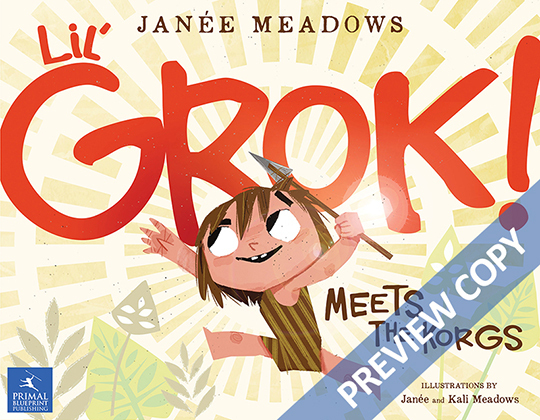
We’re all set up for you to order multiple copies, so once you’re convinced–and relieved that your holiday shopping angst about what to get your children, nieces, nephews, and neighbors has been resolved–then just tell us where to ship each one in the order notes and we’ll take care of it!
My children are all grown up, but even so I’ll be stuffing their stockings with a copy of Lil’ Grok Meets The Korgs! There’s nothing wrong with nurturing the Primal child within us all…’tis the season after all!
Just as I like to do for all Primal Blueprint Publishing book releases, I have something special put together for devoted Mark’s Daily Apple readers. Below you’ll find a limited-time (just one day!) special offer…
Special 24-Hour Offer!
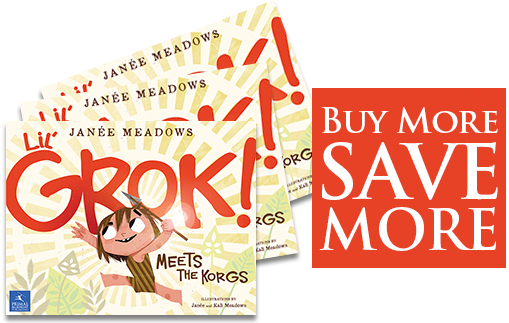
You can order single copies of Lil’ Grok Meets the Korgs at PrimalBlueprint.com starting today for just $17.95 each. (The book isn’t available on Amazon.com or at other book retailers until 2015.)
BUT, if you order 3 or more copies you’ll save 25% off the entire book order. Just add 3 copies to your shopping cart to receive the discount.
AND, if you order 5 or more copies you’ll not only save 25% off the entire book order, I’ll also include a Primal Blueprint Poster (retail value $14.95) and a Grok Key Chain (retail value $8.95).
Order today and you’ll also receive free domestic USPS Priority mail shipping to ensure your books arrive by Christmas.
This offer expires in 24 hours (Dec. 18, 8 am PST), so there’s no time to waste! Purchase several copies to hand out to friends and family, and keep the freebies for yourself!
Thanks in advance to everyone that orders a copy. And from myself and my team, we hope you enjoy the book and have a happy holidays!
Order Your Copy of Lil’ Grok Meets the Korgs Here>>


December 16, 2014
The Call of the Wild
 We civilized folk have it pretty good. Our water is clean, drinkable, and usually free of infectious microbes. The streets are paved, flat, and dotted with signs indicating our location and lamps to illuminate our way at night. All the food we could ever need or desire is a car ride, a bus ticket, or a phone call away. We have machines that safely store this food for months and even years, wash and dry our dirty clothes, shoot out hot water to wash our bodies, and maintain whichever ambient temperature we choose.
We civilized folk have it pretty good. Our water is clean, drinkable, and usually free of infectious microbes. The streets are paved, flat, and dotted with signs indicating our location and lamps to illuminate our way at night. All the food we could ever need or desire is a car ride, a bus ticket, or a phone call away. We have machines that safely store this food for months and even years, wash and dry our dirty clothes, shoot out hot water to wash our bodies, and maintain whichever ambient temperature we choose.
And those are just the basics – food, shelter, and water. When it comes to leisure time, to entertainment, we have it really good. Our televisions, tablets, laptops, and phones stream tens of thousands of high-definition movies and TV shows. The collective output of the world’s musicians, past and present, is also available for instant streaming or downloading, and we can fit thousands of books on an e-reader that fits in your back pocket. If you’d rather not pay for any of this stuff, libraries let us borrow the books, movies, TV shows, and music for free.
We’ve also got video games, board games, card games, sports, parks, swimming pools, surfboards, skateboards, snowboards, mountain bikes, road bikes, fixies, inline skates, museums, art galleries, blogs, Twitter feeds, newspapers, magazines, and literally hundreds of other enjoyable and engaging devices, hobbies, resources, and physical and mental pursuits perfect for whittling away our free time.
If the safe interiors of our constructed societies represent the pinnacle of human achievement, comfort, and cultural innovation, why do we rock climb? Why do we go helicopter skiing? Why do we tune into television shows depicting humans trying to survive on a deserted tropical island or convince a 500 pound anaconda to swallow them whole? Why are we so obsessed with Shark Week?
“It’s interesting.” Yes, it is interesting. But why?
“It’s exciting.” Absolutely. It’s cool seeing how people react to being dropping off on a deserted island.
“Sharks are awesome.” Agreed. What makes them so awesome, though? Those things are scary.
I’m not trying to come off like an annoying five year old who just learned the word “why.” Bear with me.
Why do wild animals fascinate us? Why do millions of people self-identify as hunters, bird watchers, butterfly collectors? Why, on hikes, do I still go “Oh, check it out!” every time a regular old lizard runs across my path, I narrowly miss stepping in coyote poop, or I hear a rattlesnake’s warning off in the bushes? Why was I so stoked a few years ago to snag the Planet Earth Blu-ray for half price on Black Friday?
Because the wild calls. And we listen, or at least our subconscious does, because the wild is within us.
One of my favorite pastimes is reading about the megafauna, especially the megafauna humans encountered. Between giant sloths, bull-sized rodents, ten foot tall kangaroos, elephant-sized rhinos, short-faced bears that dwarfed modern grizzlies, situationally-bipedal marsupial lions with Popeye’s forearms and Wolverine’s retractable claws, and elephant birds laying 22 pound eggs, you begin to realize that we lived in a world full of wonderful and weird and monstrous creatures. We used to face those things. We would eat them and, probably, be eaten by them. Can you imagine it? You’re among the first humans to reach Australia. You’ve just caught sight of land, you’re exhausted, and as you make your final approach the first thing you see are giant kangaroos bounding along the beach with gargantuan birds trying to escape giant eagles swooping down with 20-foot wingspans.
That’s where we come from. A world of fantastical monsters. A non-linear existence punctuated with unparalleled excitement. No, life wasn’t a blockbuster adventure movie. Most of it was sleeping, chatting, eating, laughing, hunting, gathering, fishing, tinkering, and playing — normal, everyday stuff — but the backdrop was always nature’s architecture and the potential for high adventure and full sensorial engagement was there.
And then we left. We settled into our progressively cozier and cozier civilized lives, our routines, where most days are the same, where the beasts are kept at bay. But ever since we left the wild and settled down in towns and cities and farms, the call’s gone out. It’s never stopped.
From Gilgamesh to Huck Finn, the Garden of Eden to Into the Wild, the Lord of the Flies to 60s counterculture, Jurassic Park to Planet of the Apes, Steve Irwin to David Attenborough, writers, philosophers, artists, and anyone who’s ever lived in “civilization” have grappled with and felt the pull of the wild and the savage. The polarity between civilization and wild nature is a constant force in our lives, manifesting in the media we consume and the hobbies we pursue. Even music helps us transcend normal human consciousness to access the same inexplicable sense of awe and wonder we get communing with nature.
That urge to take a sick day and watch Shark Week in your pajamas and tweet about it? That’s the call of the wild. That mountain bike we’ve been considering or those surf lesson Groupons we paid for months ago and never redeemed? That’s the wild calling for you.
You should heed it. And maybe, just maybe, get out there and get into it. In person, rediscovering nature.
I remember, clear as if it happened an hour ago, an encounter Buddha and I had with a coyote several years back. We were out in Calabasas hiking Red Rock Canyon, this gorgeous trail winding through red sandstone cliffs and caves that give off an ochre dust that covers the area. Now, Buddha’s your typical white lab – gregarious, inquisitive, and friendly but also loyal and protective. So when the coyote emerged from the bushes, feet dusted red from the dirt and looking more dog-like than you’d think, Buddha took a few steps forward, tail waving speculatively. He was bigger than I’d imagined coyotes around there got. Slight of build but long and tall and wiry. Capable, scrappy. Almost friendly, if you didn’t know better. He’d look at you, then avert his eyes when he caught you looking back.
The coyote followed us for ten minutes or so, keeping his distance. He was obviously fascinated by Buddha, this mysterious non-coyote canid blundering through his turf. Or maybe he was annoyed, just wanted us out of his territory, and this was his way of subtly escorting us along. The encounter rejuvenated me. It was small and we weren’t in any danger, but being in the presence of a wild animal — the trickster figure himself — made me feel alive. Buddha, too, if his happy trot to finish out the rest of the hike was any indication (dog owners know that trot). Maybe I’m just a sheltered victim of civilization. Maybe that’s the entire point. I could have read a Wiki entry on coyotes or watched a documentary and come away very knowledgeable, but it just isn’t the same as being in the immediate presence of one.
Now, there’s nothing wrong with watching nature documentaries. Just know that they’re probably not enough, that something vital is missing. They’re a bit like junk food. Junk food advertising works so well because it plays on our natural desires for nutrient and calorie-dense whole foods. And as we’ve discovered and shown over the past half dozen years, this mismatch between the nutritional needs and expectations of our bodies and the modern food landscape destroys physical health. We eat Pringles and pizza and drink Coke to sate the body’s demand for carbs, fat, protein, and calories because it’s all we know. But those foods don’t come with the micronutrients that their whole food corollaries (tubers, meat, fruit) come with, and we suffer, grow sick, and get fat.
We watch Attenborough documentaries, Survivor episodes, and visit the zoo to sate the body’s demand for soaring vistas, crushing surf, looming mountains, teeming forests, and close encounters with powerful and beautiful and dangerous wildlife. Those shortcuts don’t give us the micronutrients our bodies need — the stress-reducing volatile organic compounds released by trees and leaves, the sounds of bird calls and crow wings and scuttling squirrels, the feel of real earth, the uneven surfaces that make traversal more fractal and healthier, the close encounters with wildlife, the adventure, the intensity of full sensorial engagement.
They’re junk food. Junk food can be fun on top of a nutrient-dense diet, but it can’t replace real food.
That’s it for today, folks. Thanks for reading.
Do you ever notice the call of the wild? If so, how do you respond?
Prefer listening to reading? Get an audio recording of this blog post, and subscribe to the Primal Blueprint Podcast on iTunes for instant access to all past, present and future episodes here.
You CAN Lose Weight and Get Healthy. Find Out How>>


December 15, 2014
Dear Mark: Carbs at Night, Banana Breakfast, and Raw Milk Death
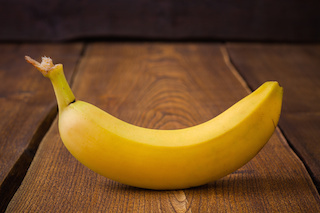 For today’s edition of Dear Mark, I’ve got three questions from readers. First is an interesting one from Brandon, who’s concerned about the nighttime consumption of carbohydrates spiking insulin enough to interfere with the growth hormone release that occurs during slow wave sleep. Should we be worried? Next, what’s the deal with bananas? A reader wonders whether his three-years-strong morning banana habit is introducing too much sugar into his system. I answer and explore the health effects of banana consumption in general. And finally, what are we to make of the recent death of a Melbourne toddler who drank bad raw milk?
For today’s edition of Dear Mark, I’ve got three questions from readers. First is an interesting one from Brandon, who’s concerned about the nighttime consumption of carbohydrates spiking insulin enough to interfere with the growth hormone release that occurs during slow wave sleep. Should we be worried? Next, what’s the deal with bananas? A reader wonders whether his three-years-strong morning banana habit is introducing too much sugar into his system. I answer and explore the health effects of banana consumption in general. And finally, what are we to make of the recent death of a Melbourne toddler who drank bad raw milk?
Let’s go:
All the evidence for nighttime carbs that you and Asprey present seems perfect except….. INSULIN
Doesn’t eating a decent amount of carbs in the afternoon/before bed cause a rise in insulin, which decreases anabolic hormones (that you want in the first bit of sleep). Also won’t the glucose give you energy (thus preventing sleep and melatonin production)?
Thanks a lot man! Any short, quick answer will do
Brandon
Great question. Yes, the presence of insulin blunts — but doesn’t abolish — growth hormone release. Since carbs increase insulin, it seems like eating them at night before you go to sleep could disrupt the much-beloved growth hormone spike that occurs shortly after falling asleep. Is this a problem?
In healthy people, your standard carb-induced insulin spike will return to baseline two or three hours after eating the carbs. So if you time things right, you can eat some carbs and get to sleep without impacting the growth hormone spike that occurs during the first three hours of sleep. Try avoiding a baked potato or sweet potato fries right before you go to sleep. Instead, eat them 2-3 hours before bedtime to give your insulin levels enough time to subside.
If you’re insulin resistant, of course, your body will probably produce more for the same amount of carbs and the insulin spike from eating carbs will last longer. One way to circumvent this: exercise. Exercise increases insulin sensitivity and, if it’s intense enough, can even activate something called non-insulin dependent glucose uptake, which is a method for increased glucose uptake by the muscles without using insulin at all. According to some researchers, “the effect of exercise is similar to the action of insulin on glucose uptake.” In fact, a bit of physical activity at night is helpful for anyone, even if it’s just some light movement, a brisk 30 minute walk, or a roll in the hay with your partner/spouse/etc.
And at any rate, human growth hormone secretion patterns are pretty robust. When we “miss” a planned surge in the hormone because we skip sleep or we’ve exercised heavily, the body makes up for it later with an “off-schedule” growth hormone surge.
As for the effect of glucose on sleep, you’re probably safe. A 2009 study found that high-glycemic (fast-digesting) carbs eaten four hours before bedtime helped subjects fall asleep faster than those who ate low-glycemic (slow-digesting) carbs. Quality of sleep was identical across both groups, suggesting that slow wave sleep — during which growth hormone is released — was unaffected by carb intake. Of course, four hours is enough time for the insulin spike to die down, so that could also be explaining the lack of an effect.
How about melatonin production? High-glycemic carbs increase the amount of circulating tryptophan relative to other amino acids, and that increases brain serotonin levels. Since brain serotonin is the precursor to melatonin, we can expect that a moderate dose of carbs at night — maybe some potato or a banana (see next question) — should in turn boost melatonin and make you sleepy. And that’s exactly what happens, according to the study above.
I have been drinking a couple of glasses of water and eating about half of a banana right after I get up in the morning for about 2-3 years. I drink water before I even clean my tongue and eat banana after.
Recently, reading your blog and finding out about all the bad sugar can do, I have gotten suspicious if eating half of a banana first thing in the morning is too much sugar for empty stomach.
I’ll appreciate your advice.
Thanks
Munish
Bananas contain sugar, but they aren’t just sugar. Sugar isn’t all that defines them.
Just so you don’t take my word for it, let’s examine some of the research into the health effects of bananas:
Among East Asians, banana consumption is inversely associated with diastolic blood pressure. More bananas, lower blood pressure.
In males, banana consumption is inversely associated with colon cancer risk. More bananas, less colon cancer.
In Swedish women, banana consumption is inversely associated with renal cell carcinoma risk. More bananas, less kidney cancer.
Bananas actually contain a significant amount of melatonin, enough to alter the urinary excretion of melatonin metabolites in healthy people. This may speed up onset of sleep when consumed at night.
Bananas are an effective prebiotic, increasing Bifidobacteria counts in healthy women. This could explain the protective colon cancer association.
Despite their carb content, they result in fairly low glycemic responses.
If you eat bananas with gold or yellow flesh, you’ll be getting a whopping dose of carotenoids.
However, don’t count on regular white-fleshed bananas for your polyphenol intake. Along with melons, bananas have some of the lowest antioxidant capacities among fruits. That doesn’t make them unhealthy. It just means you should also be sure to eat berries, cherries, and other fruits rich in polyphenols.
Your half banana habit is fine, Munish, especially if you’ve been doing it for years without an issue. Keep doing what works! You could switch things up every now and then and eat a greenish banana instead of the riper ones. Less of the starch in a green banana will be digestible, lowering the blood glucose response, giving you a bigger dose of resistant starch to feed your gut bacteria, and improving your digestive and probably overall health. Resistant starch starts converting to sugar as the banana ripens.
But you should really watch out for that water. It’s deadly stuff. Did you know it inhibits breathing?
Hey Mark, just seen this on the Daily Mail about a child dying from drinking raw milk? What are your thoughts?
Paul
Man, what a terrible story. Very sad. I’d be careful about consuming any raw dairy not sold for human consumption because there are fewer consumer protections put in place when you’re buying “pet milk” or “bath milk.” Rather than highlight the dangers of consuming any and all raw milk, it actually highlights the health risks of raw milk prohibition and relegating the product to an illegal market. Had the milk been subjected to regular tests — commonplace wherever raw milk is legally sold for human consumption — the microbial loads would have been detected and the milk discarded. For that reason, I would avoid consuming any raw dairy not explicitly sold for human consumption.
When raw milk can be sold for human consumption, producers no longer have to operate in the shadows. They must keep up with safety inspections, quality control assurances, and regular testing. As it stands, raw milk legally sold for human consumption is still fairly safe in general. But nothing is completely safe. And yes, when raw milk is bad, you have the potential to get a really bad batch of raw milk.
This is an argument for legalization as much as it’s an argument against off-label consumption of bath milk, if anything. Without full legal acceptance, these admittedly rare occurrences will keep happening because the demand for an otherwise nourishing food like raw milk is only increasing.
Thanks for reading, everyone. Be sure to give you input/feedback below. Have a great rest of the week!
You CAN Lose Weight and Get Healthy. Find Out How>>


December 14, 2014
Weekend Link Love – Edition 326
 Chef Rachel Albert, Healthy Cooking Coach and dear personal friend, has been battling stage IV metastatic breast cancer for three years. She has one small spot left to clear up, but her treatment has hit her pretty hard financially and she’s asking for your help. If you can spare anything, it would mean a lot to her and to me.
Chef Rachel Albert, Healthy Cooking Coach and dear personal friend, has been battling stage IV metastatic breast cancer for three years. She has one small spot left to clear up, but her treatment has hit her pretty hard financially and she’s asking for your help. If you can spare anything, it would mean a lot to her and to me.
Dropped by the Dr. Oz show recently to represent for the paleo movement. The episode aired last Friday, a preview of which can be viewed here. Let me know what you think in the comment board.
In case you missed the big announcement, Primal Mayo is coming soon! Check out the announcement post and be sure to enter to win a jar from the very first batch.
Ever wonder what you’re made of? Starting tomorrow and going through Friday the 19th, Ben Greenfield is putting on REV Yourself, a free online conference where Ben and 25 health and performance experts (including yours truly) help you discover and realize your ultimate performance potential. Everything goes live tomorrow, so sign up today!
I hung out with James Maskell of the Evolution of Medicine podcast to talk about hidden genetic switches, the microbiome, and why doctors need to be part of our movement. Give it a listen.
Research of the Week
A randomized controlled trial in elderly Korean adults found that drinking soy milk from a can caused increases in urinary BPA and blood pressure that were not seen in those drinking soy milk from a glass bottle.
Prenatal exposure to two common phthalates was linked to a big drop in child IQ at age 7.
Reducing the number of continuous hours a medical resident could work caused no additional patient deaths or hospital readmissions.
When organic farmers implement “agroecological practices like intercropping and crop rotations,” the yield differences between organic and conventional agriculture all but disappear.
New Primal Blueprint Podcasts
Episode 46: Interview with Ronda Collier: How Heart Rate Variability Can Help You Manage Stress – Brad Kearns sits down with Ronda Collier, CEO of Sweetwater Health, makers of the Sweetbeat Life, which is my favorite heart rate variability monitoring app on iOS. Brock Armstrong, the voice of the MDA blog podcasts and ambassador for Sweetbeat, also joins the party. HRV just might be the most powerful biomarker available for assessing stress, recovery, and overall health, and today’s podcast will tell you everything you need to know about monitoring it.
Each week, select Mark’s Daily Apple blog posts are prepared as Primal Blueprint Podcasts. Need to catch up on reading, but don’t have the time? Prefer to listen to articles while on the go? Check out the new blog post podcasts below, and subscribe to the Primal Blueprint Podcast here so you never miss an episode.
The Quest for a Healthy Primal Mayonnaise
9 Worthy Alternatives to the Back Squat
Examining the Concept of Self-Care
Interesting Blog Posts
Instead of issuing dire warnings against the use of ketogenic diets in brain cancer patients, perhaps we should be warning against not trying them.
Civilization (sorry, UKers, but I gotta go with “z”) is boring.
Media, Schmedia
If your doctor writes you a prescription for exercise, does that mean your insurance company pays for your squat rack?
A Colorado elementary school district is giving its students outdoor “Vitamin D breaks.”
Everything Else
The ability to detoxify and digest alcohol-containing fermenting forest fruits may have played a key role in our evolution.
Our oceans contain a minimum of 269,000 tons of plastic, according to researchers. But a lot of it is still unaccounted for.
Want to learn how to integrate Allan Savory’s holistic methods into your own land and livestock management? There’s an online certification for that.
Coca-Cola is making milk?
Recipe Corner
If you can’t go to Hawaii to escape winter weather, at least you can make this Hawaiian pork roast.
Forget lettuce wraps. It’s all about swiss chard wraps (with tuna salad).
Time Capsule
One year ago (Dec 14– Dec 20)
10 Common Arguments Against Dairy Consumption Explored – Does the case against dairy hold up to scrutiny?
A Primal Take on the Holidays: Surviving or Thriving? – Rather than think of the holidays as a bitter struggle to keep our heads above water, perhaps we should embrace it.
Comment of the Week
The highest risk alternative is doing the diddly squat.
– Well done.
You CAN Lose Weight and Get Healthy. Find Out How>>


December 13, 2014
Braised Duck and Kabocha Squash
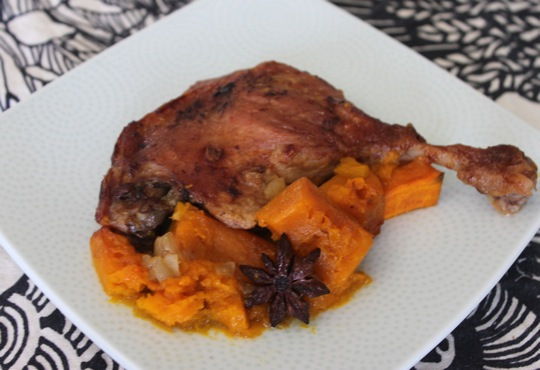 Especially on a cold winter evening, a house filled with the deliciously gamey and sweet aroma of duck braised with kabocha squash is incredibly comforting. The duck legs are both tender and crisp and the squash is downright decadent, with a velvety, melt-in-your-mouth texture and a hint of exotic spice from star anise.
Especially on a cold winter evening, a house filled with the deliciously gamey and sweet aroma of duck braised with kabocha squash is incredibly comforting. The duck legs are both tender and crisp and the squash is downright decadent, with a velvety, melt-in-your-mouth texture and a hint of exotic spice from star anise.
This flavorful and luxurious-tasting dish makes a strong case for always cooking root vegetables in duck fat. Heck, it makes a strong case for cooking everything in duck fat. Luckily, you’ll have some leftover to store in the refrigerator for future recipes. Use duck fat to saute anything, rub down chicken before cooking, or roast vegetables. It adds a subtle meaty flavor to food, can be used for high-heat cooking and makes both roasted poultry skin and vegetables extra crispy.
Kabocha is a winter squash with a mildly sweet flavor and smooth, tender texture. Most recipes pair duck with starchy potatoes, but squash is even better, in terms of both health and flavor. The sweetness of squash is so good with fatty duck, it’s hard to imagine why you’d want anything else.
Servings: 4
Time in the Kitchen: 45 minutes, plus 1 1/2 hours to braise
Ingredients:
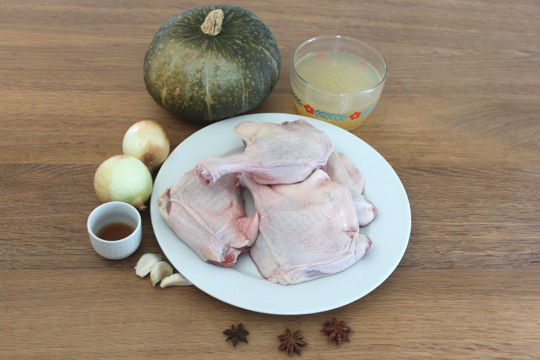
4 duck legs
1 large onion or two small, finely chopped
3 garlic cloves, finely chopped
3 whole star anise
2 to 4 cups chicken stock (475 ml to 950 ml)
1 kabocha squash, peeled seeded and cut into 1 to 1 1/2-inch cubes
1 tablespoon apple cider vinegar (15 ml)
Instructions:
Preheat oven to 325 ºF/190 ºC.
Season the duck legs with salt and pepper.
Place them skin side down in a large ovenproof skillet over medium heat. Cook slowly and patiently, undisturbed, until the skin is very well browned and crisp, about 20 minutes. Transfer them to a plate and drain off all but 2 tablespoons of the fat from the skillet (save the extra fat for another use, it will keep for a couple months in the refrigerator).
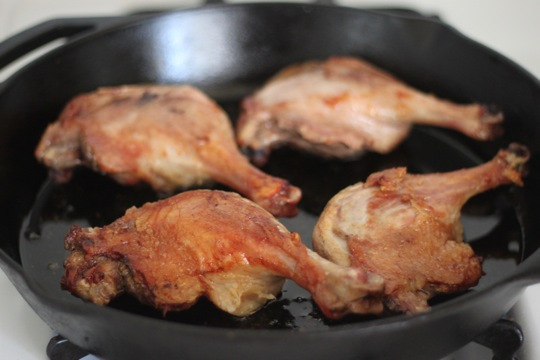
Add the onion and garlic to the skillet and cook in the duck fat until golden-brown, 7 to 10 minutes.
Arrange the duck legs in the skillet, skin side up, on top of the onion and garlic. Scatter the squash around the duck then add the star anise and just enough chicken stock to come halfway up the duck legs but not cover them completely – the skin should be exposed. If the skin is covered with liquid, it won’t stay crispy.
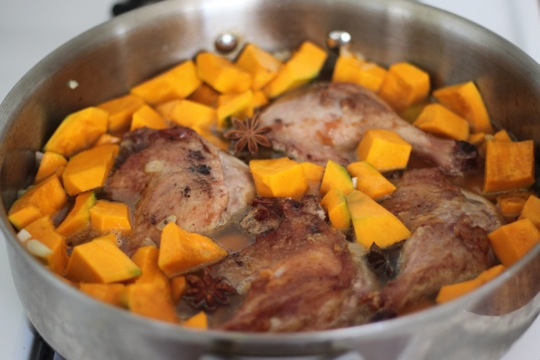
Increase the heat to high and bring the liquid to a boil.
Put the skillet in the oven (no lid). Cook for 1 1/2 hours or until fork tender.
Let the duck rest for about 10 minutes. Drizzle the vinegar over the dish and serve.
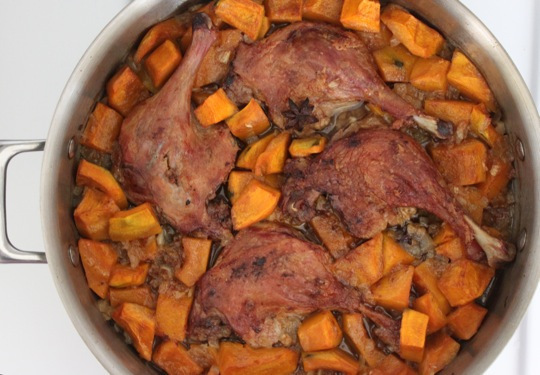
Not Sure What to Eat? Get the Primal Blueprint Meal Plan for Shopping Lists and Recipes Delivered Directly to Your Inbox Each Week


December 12, 2014
Health Coaches Find Success with the Primal Blueprint Certification Program
It’s Friday, everyone! And that means another Primal Blueprint Real Life Story from a Mark’s Daily Apple reader. If you have your own success story and would like to share it with me and the Mark’s Daily Apple community please contact me here. I’ll continue to publish these each Friday as long as they keep coming in. Thank you for reading!
 Greetings readers, certainly you’ve heard about the great reception and momentum created with the launch of the Primal Blueprint Expert Certification back in late August. We have nearly 500 students in our program now, and over 100 have already graduated and attained their Primal Blueprint Certified Expert status. I started this program as a way to offer a deeper experience to the Primal enthusiast who craved more, or perhaps wanted to enhance his or her professional standing with more education. It’s gratifying to notice that we indeed have a hard-core subsection within the Primal/paleo/ancestral health community that wants to truly “own” the principles, the philosophy, and the practical elements of day-to-day Primal living.
Greetings readers, certainly you’ve heard about the great reception and momentum created with the launch of the Primal Blueprint Expert Certification back in late August. We have nearly 500 students in our program now, and over 100 have already graduated and attained their Primal Blueprint Certified Expert status. I started this program as a way to offer a deeper experience to the Primal enthusiast who craved more, or perhaps wanted to enhance his or her professional standing with more education. It’s gratifying to notice that we indeed have a hard-core subsection within the Primal/paleo/ancestral health community that wants to truly “own” the principles, the philosophy, and the practical elements of day-to-day Primal living.
The “Cert” follows one of my guiding life principles—Invest in Yourself! Many of our students indeed come from the professional ranks in medicine, health, fitness, and life coaching professions, and are leveraging their Primal education into true business momentum. Check out Elle Russ’s operation, which has really taken off following her graduation and appearance on the Primal Blueprint Podcast. Many more have taken on the Expert Certification challenge purely for personal growth, or as a stepping-stone to an aspired career change in the future. I want you to meet some of them and learn their stories, so we’ve profiled a select group of Cert graduates with interesting and inspiring messages in this post.
One of the most empowering things about the Cert is that we can publish fresh, continually updated content with the click of a button. In the book publishing business, frustration arises when you reflect on your published matter and wish you could say things differently, or elaborate on a concept that many people told you was confusing. Heck, I even want to change the cover of The Primal Connection, because as artistic and symbolic as it is, it seems like many people fail to make the “connection” to The Primal Blueprint—pardon the pun.
2015 New and Improved Primal Blueprint
As an aside, and speaking of the daunting task of updating and revising published material; I’m doing just that with The Primal Blueprint for 2015. Realize that I started writing this thing in 2008(!), which is an eternity in the burgeoning field of ancestral health. My team and I did some basic revisions and enhancements when we converted to paperback in 2011, but now it’s time for a comprehensive updated, enhanced, and revised edition in 2015. While much of the message and prose in the original manuscript is still spot on, there is an assortment of topics like gut health, creating a dynamic workplace, and heart rate variability to track stress and exercise recovery that weren’t really on the radar when the book first came out.
Furthermore, thanks to you guys at MDA and the many prominent, passionate thought leaders in the movement, I’ve been inspired to rethink and revise my position on some core topics since the original Primal Blueprint came out. I am going all-out on this “new and improved PB” project to the extent that when the 2015 Primal Blueprint is released, I will be able to sincerely assert that everyone who read the original edition must update their library with the new one!
For instance, I’ve completely revised my stance on alcohol, which The Primal Blueprint originally categorized (red wine specifically) as a “sensible indulgence.” After reading new research about alcohol’s potentially negative effect on gut health and fat metabolism, and after conducting an n=1 abstention experiment with favorable results, I’ve revised my position on alcohol—yes, even red wine.
The Latest and Greatest in the Cert
The Expert Certification course goes into extensive detail on the alcohol topic and represents my latest, greatest take on the subject. Hint: there are better ways to manage stress, and if you are struggling to drop excess body fat, alcohol can be one of your first factors to blame for stalled progress.
I believe heart rate variability is the greatest innovation to help athletes monitor stress, recovery, overtraining, and fitness progress since the advent of the wireless heart rate monitor in the mid 80s. It’s seriously cool stuff that I’ve delved deeper and deeper into only in the past six months. Well, the extensive discussion of HRV in the Cert course again represents my latest take on this topic, and I can go on and on with other topics. In fact, since the launch of the Cert course in late August, my research team and I have processed 27 significant revisions to the original course material. Death By Food Pyramid author Denise Minger, now part of our staff as well as a member of the Expert Certification Advisory Board, did some tremendous work in Module #6, “Fat and Cholesterol Are Not Your Enemy.” Our software designer, the amazing Justin Miller, finally saw the light and trained our in-house staff to make live revisions into the sophisticated course and examination software!
As for the examination questions, user feedback and chop-busting has resulted in literally dozens of revisions or entirely replaced questions since the original launch. It’s good fun, and it represents great progress from the staid old days of that static set of Encyclopedia Britannica—representing the ultimate collection of knowledge and information available anywhere on the planet (I wonder if that company even exists anymore? Hmm, let me Google them and find out!).
We’re also in the process of adding several dozen audio enhancements to the live course. These are short “sound bites” that you can hear by clicking on a play button icon that appears frequently throughout the written text. You can enjoy some “unplugged” enrichment or more emphatic explanation of the message presented in writing. These sound bites, recorded by Certification Program coordinator Brad Kearns, are an attempt to diversify the educational experience for enhanced interest and retention of the material, and also to achieve maximum effectiveness with people of assorted dominant learning modalities.
In summary, we are totally committed to leading the way as a provider of continuing education to our wonderful ancestral health community, and will continue to strive for constant progress in growing and gaining more mainstream acceptance. I kind of predicted this in the intro to the original Primal Blueprint when I speculated change would come quickly because people are “sick and tired of being sick and tired!”
On that note, I want to give you a heads up that our current introductory price of $795 will end on December 15th, and the Expert Certification program enrollment fee will become $995. We really appreciate the contribution and support of our early adopters, and I also appreciate the support of MDA readers, so I’m inviting you to take advantage of the introductory price until December 15th. I understand that it’s the holiday season and I’m springing this on you with minimal advance notice, so how does this sound? If you’ve been sitting on the fence thinking about taking the Cert (and thinking even more about the Cert knowing the price is about to rise!) but are sensitive to the budget impact, just make the commitment to become a student right away and we’ll put you on a payment plan over the next four months—locked in at the introductory rate of $795. Some folks have even asked for and been granted a lengthier payment plan, so check in with us with your sincere interest and we’ll make something work for you. Now, without further delay, let’s meet some of our incredible graduates and enjoy their stories.
Carolyn Gray
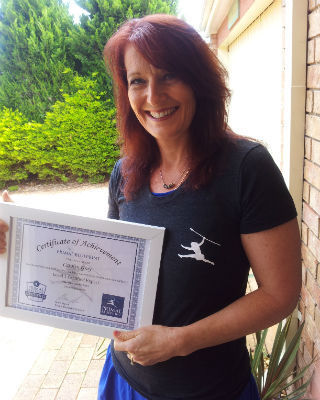 As soon as l saw the advertisement for the Primal Blueprint Expert Certification l knew it was for me. I had spent the past one and a half years rebuilding my health after suffering a chronic illness, and Primal Nutrition played a significant role in my recovery. I had recently completed a general nutrition course and was looking for a program that would build on the knowledge l already had. I was absolutely delighted with what the Primal Blueprint had to offer and found the course incredibly stimulating. I appreciated the very high standards expected and challenged myself to do well in the tests, where a pass was a high 75%. I enjoyed the content of the program and thought it was an exceptional value, as there were numerous free digital resources included upon enrollment, such as books and videos. And, on completion, an exciting box arrived from Primal Blueprint headquarters filled with congratulatory gifts such as books, an excellent t-shirt, and a certificate that l proudly display on my office wall.
As soon as l saw the advertisement for the Primal Blueprint Expert Certification l knew it was for me. I had spent the past one and a half years rebuilding my health after suffering a chronic illness, and Primal Nutrition played a significant role in my recovery. I had recently completed a general nutrition course and was looking for a program that would build on the knowledge l already had. I was absolutely delighted with what the Primal Blueprint had to offer and found the course incredibly stimulating. I appreciated the very high standards expected and challenged myself to do well in the tests, where a pass was a high 75%. I enjoyed the content of the program and thought it was an exceptional value, as there were numerous free digital resources included upon enrollment, such as books and videos. And, on completion, an exciting box arrived from Primal Blueprint headquarters filled with congratulatory gifts such as books, an excellent t-shirt, and a certificate that l proudly display on my office wall.
Mark Sisson’s story of being at the top of his profession yet having so many health problems really hit home with me because (before becoming unwell) l was a chronic exerciser and was told by so many doctors that l was fine. I think Mark Sisson is an inspiring person and admire his commitment to health as a top priority in his life and found the Cert to be a real drawcard in wanting to become more involved with the Primal Blueprint. I have listened to Mark speak on numerous podcasts and admire his intelligence, honesty, and ability to reflect on his own life. This professionalism underpins the Primal Blueprint organization, which has supported me both throughout the course and also on completion with prompt and friendly communication. I feel part of the Primal Blueprint team and family now, as l am one of a select few who has completed this life-changing program.
I really believe in the concepts that underpin the Primal Blueprint and want to share the message that we can promote positive gene expression in our bodies through nutrition and lifestyle. I reflect on my own life and the lives of those around me and feel that we have lost our way in this modern world. The Primal Blueprint can help to simplify daily living by promoting healthy food and lifestyle choices that suit our genetic makeup.
I now have the knowledge to enhance my own life and also incorporate the Primal Blueprint philosophies into my nutrition and wellness coaching business. On completion of the course, graduates are generously offered the use of particular Primal Blueprint logos, which l am using on social media and on my website at www.holisticwellnessforlife.com. I am now planning to run a 12-week group program where l share what l have learned to those living in my local community. Completing the Primal Blueprint Expert Certification has been an amazing experience and is the start of a wonderful journey.
Gabriella Schneider
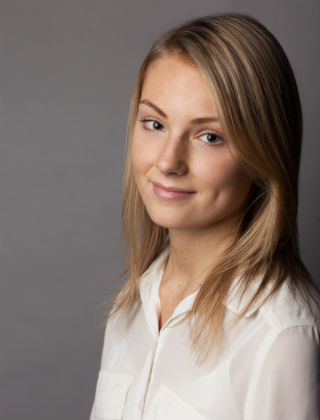 The Primal Blueprint Expert Certification is by far the greatest source of information for anyone who wants to go up and beyond the preconceived boundaries of today’s modern life. Whether interested in sports, food, the human body, or how other aspects of life such as technology, sunlight, and sleep affect us, the Primal Blueprint has got you covered. Due to chronic Lyme disease, I am not yet healthy enough to tackle the schedule of college courses. Therefore, when I heard about the Primal Blueprint Expert Certification, I was ecstatic.
The Primal Blueprint Expert Certification is by far the greatest source of information for anyone who wants to go up and beyond the preconceived boundaries of today’s modern life. Whether interested in sports, food, the human body, or how other aspects of life such as technology, sunlight, and sleep affect us, the Primal Blueprint has got you covered. Due to chronic Lyme disease, I am not yet healthy enough to tackle the schedule of college courses. Therefore, when I heard about the Primal Blueprint Expert Certification, I was ecstatic.
With no due dates or specific class times, I was able to learn at my own pace, without the stress of missing an assignment. Not only that, but I was able to study anywhere, whether in the car, at a doctor’s appointment, or from the comfort of my own bed. Sitting down every day and diving into what the course had to teach me was challenging, yet very exciting and fun. I could not wait to finish each module, simply for the reason that I wanted to go on to the next and learn more.
Because chronic Lyme disease is very misunderstood, I have taken on the responsibility of researching information about health and the human body. That being said, though I spend numerous hours researching in-depth, scientific information, the Primal Blueprint Expert Certification still presented me with information that I had yet to learn. However, it is not to say that it was overwhelming, as Mark Sisson always breaks it down in a way that is applicable to any stage of life.
One of the most influential aspects of the course was learning about how our bodies prefer fat to carbohydrates for energy and life. I also was filled with information that I will be able to apply once I have healed from Lyme, such as finding true peak fitness, as well as how easy, enjoyable, and beneficial exercise was meant (and easily can) be.
We are born being told lie after lie, yet by taking the Primal Blueprint Expert Certification, the weight of this conventional dogma has been lifted off my shoulders. Instead of the world being a difficult and seemingly impossible place to live in, I now see exercise, play, sleeping, family, friends, and even my own body, in a whole new light. Ultimately, it gave me the confidence and the hope that, yes, I can beat the seemingly incurable chronic Lyme disease.
Larry Diamond
After using the resources on Mark’s Daily Apple to transform the health of myself and my first two “clients,” my wife and daughter, Primal living has become a true passion of mine. Because of this, I decided to pursue the Certification to solidify and deepen my understanding of the science behind Primal transformations and how to best convey and apply this understanding to others. I did this with the intent to help blossom my passion to avocation and then possibly vocation in Primal living.
The course met and exceeded my expectations. First, it is extremely easy to use on any computer or tablet. Each module contains an introduction/overview video by Mark himself, followed by very well-written content that was clearly based on the most current and best understood Primal nutrition, life, and exercise information available. Each module is finished by a “Coaching Your Client” section, which has useful suggestions on how to convey and apply the information to yourself, family, friends, or clients. Although I felt I was a well-informed layperson on the material, every module contained new information for me. The test questions were fair and representative of both broad and detailed aspects of each module.
I found the Five Action Item modules very useful personally, as they have helped increase the efficiency and benefits of my exercise routine and helped me make even better informed nutrition decisions. There is also a wealth of resources you get from the course. You get PDFs, audio books, and two complete video presentations to enjoy right away while taking the course. Then, once the course is completed, you get a lot of useful Primal “swag” to enjoy. This includes hard copies of the 21-Day Total Body Transformation and the 90 Day Journal you can share with family or clients. Plus, you get significant ongoing discounts to Primal supplements and apparel. You also have an opportunity to join a Facebook group of Primal Certified Experts, which I have found to be very helpful and informative. There is a lot of good sharing that takes place there.
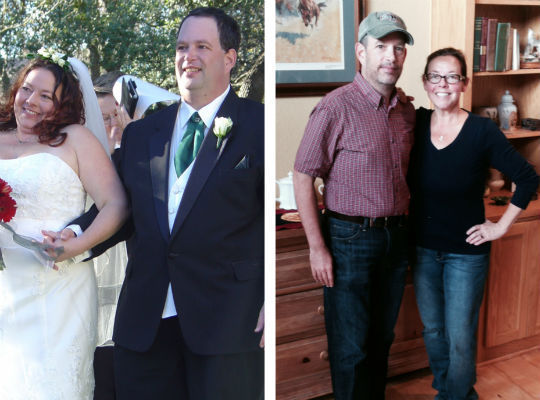
The Certification has given me more confidence and credibility with which to give public lectures, and will no doubt continue to open up doors to grow my Primal passion into larger and more significant projects. I am not a professional trainer or medical professional, but the course has hands down been worth it on practical levels for me and my family, helping us take our health and strength to new levels. Plus, it is giving me opportunities to further my passion into fun and fulfilling projects.
Candice Mitchell
Before I discovered The Primal Blueprint, I was the It Girl—if by “It” you mean “hangry.” I was also a vegetarian—if by “vegetarian” you mean “carbivore.” And I was healthy—if by “healthy” you mean “slave to eating every two hours, having less than optimal muscle tone, not sleeping notably well, beholden to hormonal fluctuations, spouting conventional wisdom about eating less fat and eating more healthy whole grains…basically surviving, but not thriving.”
Why, oh why, would I give all that up, you ask? It wasn’t my plan. It started at a luncheon for hospice. I came hungry—knowing me, probably even “hangry.” And guess what was on the table? Well, there was a breadbasket, a weak green salad topped with a grilled chicken breast, and chocolate cake. It was practically a social experiment! What was a vegetarian to do?
I could have demolished the breadbasket and the wimpy little offering of lettuce… oh, and the chocolate cake, of course. And I would have felt “morally satisfied” for sticking to my sixteen-year history of “being a vegetarian.” But I realized that the only thing that looked substantial and healthy was that grilled chicken breast. So…I ate it (and the wimpy greens, of course)!
I was immediately changed. I had missed this—this feeling of wholesome fullness. That night I went home and researched. The Tofurky I had been eating with a misguided halo over my head was not easily classified as animal, mineral, or vegetable. Ugh! After tooling around the Internet, I found the goldmine that is Mark’s Daily Apple. And I ordered the goldmine that is the book The Primal Blueprint.
I have not looked back. I am healthy. I have incredible strength and muscle tone. I am happy. My shoulder and back pain are GONE! I sleep like a baby! I am not beholden to my appetite. I am FULL in every sense of the word!
And then came the offer to become a Primal Blueprint Certified Expert. This was the cherry on top. Through the program, I have been equipped with both hot-off-the-press science regarding nutrition and fitness as well as the history of how we evolved as a species. I have the confidence to navigate my world. And I have been able to assist others in their Primal journeys! I have a client that has already lost 21 pounds and another that has lost 10. And it’s not only about what’s been lost, but it’s also about what they’ve gained: energy, better sleep, more stable moods… the list goes on.
I am so grateful for Mark’s Daily Apple and for the Primal Blueprint Certified Expert program for CHANGING MY LIFE! I can’t stress it enough. I’m over the moon!
Thank you to ALL who have made this program possible.
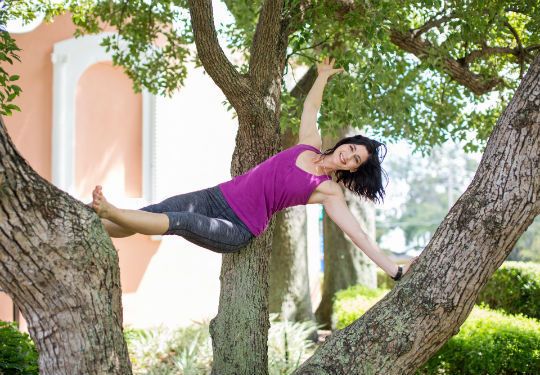
—
These experts have a (private) Facebook page that is blowing up with great exchange of opinion, entertainment, and education, and Elle Russ and Mike DiLandro are formulating plans to publish a regular podcast just for certified experts.
A couple more things: Seth Godin asserts that 98% of people who commence an online education self-study course fail to complete it. The reason attributed is that starting a course is fun and inspiring, while finishing a course is hard work. This is a disturbing concept to absorb now that my company is in the online education business. This concept is an affront to my personal and business values, and we are going to do everything we can to ensure you have an enjoyable journey as a student and a successful completion of the program. Candidly, our commitment to student support has resulted in a handful of full refunds to students who entered the course, and despite our sincere one-on-one support efforts (spearheaded by our exceptional Daniel Rinck, a recent UCLA philosophy grad who is quickly bonding with many of our students for his timely and insightful support on anything and everything they need during their course of study), determined it was not a good fit.
Last, we have decided to conduct a monthly webinar for Cert students and grads, hosted by Brad Kearns and featuring occasional expert guests. There will be some group support and feedback exchanged with a focus on studying tips, motivation, discipline, sensible pacing, and other success factors that great students embody—even in the face of the busy, multifaceted life you are likely leading. Thanks for your interest, and I look forward to seeing you on our directory of Primal Blueprint Certified Experts!
You CAN Lose Weight and Get Healthy. Find Out How>>


Mark Sisson's Blog
- Mark Sisson's profile
- 199 followers


